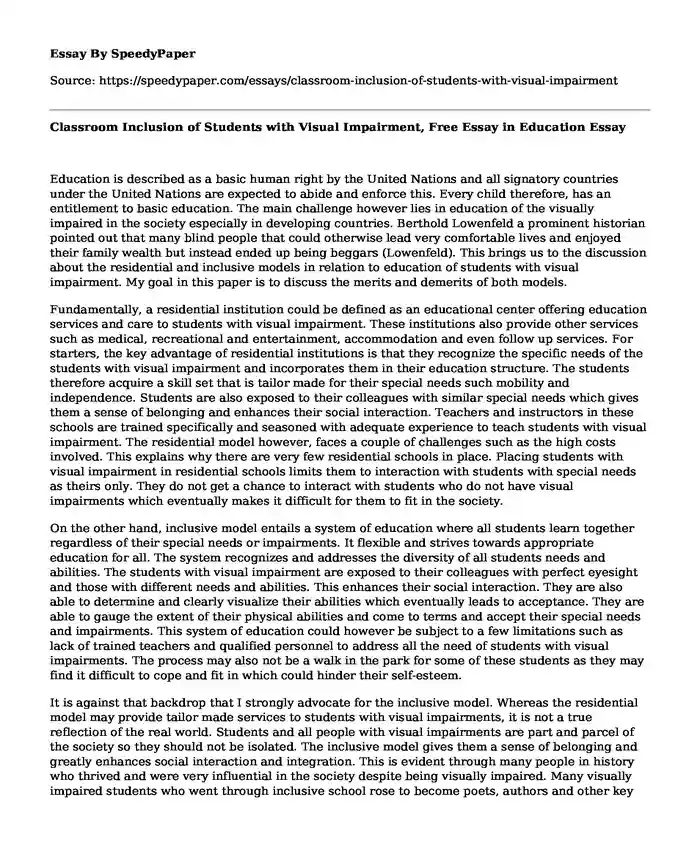
| Type of paper: | Essay |
| Categories: | Teaching Pedagogy Special education |
| Pages: | 3 |
| Wordcount: | 638 words |
Education is described as a basic human right by the United Nations and all signatory countries under the United Nations are expected to abide and enforce this. Every child therefore, has an entitlement to basic education. The main challenge however lies in education of the visually impaired in the society especially in developing countries. Berthold Lowenfeld a prominent historian pointed out that many blind people that could otherwise lead very comfortable lives and enjoyed their family wealth but instead ended up being beggars (Lowenfeld). This brings us to the discussion about the residential and inclusive models in relation to education of students with visual impairment. My goal in this paper is to discuss the merits and demerits of both models.
Fundamentally, a residential institution could be defined as an educational center offering education services and care to students with visual impairment. These institutions also provide other services such as medical, recreational and entertainment, accommodation and even follow up services. For starters, the key advantage of residential institutions is that they recognize the specific needs of the students with visual impairment and incorporates them in their education structure. The students therefore acquire a skill set that is tailor made for their special needs such mobility and independence. Students are also exposed to their colleagues with similar special needs which gives them a sense of belonging and enhances their social interaction. Teachers and instructors in these schools are trained specifically and seasoned with adequate experience to teach students with visual impairment. The residential model however, faces a couple of challenges such as the high costs involved. This explains why there are very few residential schools in place. Placing students with visual impairment in residential schools limits them to interaction with students with special needs as theirs only. They do not get a chance to interact with students who do not have visual impairments which eventually makes it difficult for them to fit in the society.
On the other hand, inclusive model entails a system of education where all students learn together regardless of their special needs or impairments. It flexible and strives towards appropriate education for all. The system recognizes and addresses the diversity of all students needs and abilities. The students with visual impairment are exposed to their colleagues with perfect eyesight and those with different needs and abilities. This enhances their social interaction. They are also able to determine and clearly visualize their abilities which eventually leads to acceptance. They are able to gauge the extent of their physical abilities and come to terms and accept their special needs and impairments. This system of education could however be subject to a few limitations such as lack of trained teachers and qualified personnel to address all the need of students with visual impairments. The process may also not be a walk in the park for some of these students as they may find it difficult to cope and fit in which could hinder their self-esteem.
It is against that backdrop that I strongly advocate for the inclusive model. Whereas the residential model may provide tailor made services to students with visual impairments, it is not a true reflection of the real world. Students and all people with visual impairments are part and parcel of the society so they should not be isolated. The inclusive model gives them a sense of belonging and greatly enhances social interaction and integration. This is evident through many people in history who thrived and were very influential in the society despite being visually impaired. Many visually impaired students who went through inclusive school rose to become poets, authors and other key figures in the society a true indication of the efficiency of this model.
Works Cited
Lowenfeld, Berthold. The Changing Status of the Blind:From Separation to Integration. Springfield: Charles C Thomas, 1975. Print.
Cite this page
Classroom Inclusion of Students with Visual Impairment, Free Essay in Education. (2019, May 31). Retrieved from https://speedypaper.net/essays/classroom-inclusion-of-students-with-visual-impairment
Request Removal
If you are the original author of this essay and no longer wish to have it published on the SpeedyPaper website, please click below to request its removal:
- Free Essay: Comparison and Contrast of Irene Redfield and Clare Kendry in Nella Larsens Passing
- Importance of Stories - Essay Example in Psychology
- Essay Example on Therapeutic Boundaries Violations
- Free Essay on Reduction of Air Pollution Using Bio Fuels as Form of Renewable Energy
- Nursing Essay Sample: Characteristics of Research Utilization and Evidence-Based Practice
- Article Review: Trump Threatens Tariffs on All Imports From China; Escalating Trade Feud
- Functionality Of The Cell
Popular categories




